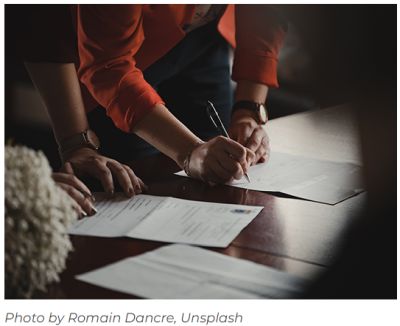No one sets out to draft an imprecise license agreement; occasionally that is the unfortunate result. Negotiation helps get what you want.
No one sets out to draft an imprecise license agreement, but occasionally that is the unfortunate result. One source of imprecision is that the inherent ambiguity is not always apparent at the time of negotiation – it is difficult to predict the future. Another source of imprecision is that it is sometimes simply tolerated because of negotiation fatigue – "Close enough, let's sign." A final source of imprecision is the fear that further clarification might adversely affect the terms.
The majority of license agreements are successes, with the licensor and licensee each performing their respective obligations and never looking at the agreement again. However, whatever the source, imprecision sometimes causes spectacularly bad results, particularly where that ambiguity concerns who is granting the license, who is receiving license and what is being licensed. Each of these elements needs to be carefully thought out and defined, not just for the current time frame but for the future as well.

Who is the Licensor?
The licensors are always defined in the license agreement, but depending upon the definition, this can change over time – and with them, the scope of the licensed properties. This was recently illustrated in VLSI Tech. LLC v. Intel. Corp., 2023 U.S. App. LEXIS 31861, __ F.4th __ (Fed. Cir. 2023).
VLSI sued Intel for patent infringement, and in March 2021, the jury awarded VLSI $1.5 billion for infringement of U.S. Patent No. 7,523,373 and $675 million for infringement of U.S. Patent No. 7,725,759. On appeal, Intel complained that the district court should have allowed it to present a license defense. It turns out that in 2012 Finjan granted Intel a perpetual and irrevocable license to patents owned and controlled by Finjan's "affiliates," defined as "any Person that, now or hereafter, directly or indirectly through one or more entities, controls or is controlled by, or is under common control with" Finjan. Intel pointed out that before trial Finjan was acquired by Fortress (which owned VLSI). This caused Finjan and VLSI to be under the common control of Fortress, and according to Intel, "affiliates" under the provisions of the Finjan license. Intel argued that it was therefore licensed under the VLSI patents, and could not be an infringer. The Federal Circuit did not rule on this defense, but did find that the district court erred in not considering it, and vacated the $1.5 billion judgment and remanded the case back to the district court judge for further proceedings.
In 2012, Finjan could not have predicted that the license it was granting Intel would, eight years later, jeopardize a $1.5 billion damage award to an "affiliate", but Finjan could have more carefully controlled whose patents were covered by the license, and in particular when the status of the term affiliate is determined.
Who is the Licensee?
Imation Corp. v. Koninklijke Philips Electronics N.V., 586 F.3d 980 (Fed. Cir. 2009), presented the opposite situation from VLSI: the addition of licensees, rather than licensors.
Phillips and Imation's predecessor 3M entered into a cross-license agreement, under which Phillips "agrees to grant and does hereby grant to [Imation] and its Subsidiaries a personal, non-exclusive, indivisible, nontransferable, irrevocable, worldwide, royalty-free license under Philips Licensed Patents to make, have made, make for others, use, lease, distribute, offer to sell, sell, import, or otherwise dispose of Licensed Products."
While the agreement only lasted five years, it provided that any patent license which had been granted under the license provision continued, as to each licensed patent, for the life of such patent.
After the expiration of the license agreement, Imation added to new affiliates, and sued Phillips for a declaration that these affiliates were also licensed under the Phillips patents. This district court found otherwise, but the Federal Circuit found that the "does hereby grant" language in the agreement constituted a present license grant to a class comprised of Imation and each "Subsidiary," which class may shrink or grow over time as entities become or cease to be "Subsidiaries." The district court also found the term "hereafter" to be limited to the period of time up until the expiration of the agreement, but the Federal Circuit disagreed, finding that if the parties had intended to limit the group of "Subsidiaries" to those in existence at a certain time, they could have said so. Instead, the plain language of the relevant provision contains no such explicit temporal limitation, and the Federal Circuit was "extremely reluctant to interpret an agreement as impliedly stating something which the parties have neglected to specifically include."
When considering what additional licensees can be added, it is important to define not just who can be added, but when they can be added. As the Federal Circuit said, if the parties intended to limit the group to those in existence at a certain time, they could have done so.
A different result was reached in nQueue v. Control Systems (USA), CV 12-01365 BRO (C.D. Cal. November 27, 2013), where Control Systems was being sued for patent infringement by nQueue. A few months after the suit was filed, Control System's parent was bought by Equitrac. From previous litigation, Equitrac had a license from nQueue to the asserted patent that extended to "affiliates", defined as any entity "that controls, or is controlled by, or is under common control with that Party (either directly or indirectly) as of the Effective Date of the Agreement." As a wholly owned subsidiary of Equitrac, Control Systems tried to claim the benefit of the Equitrac's license, but the court found that defendant could not be an Affiliate of Equitrac because it was not under Equitrac's control "as of the Effective Date of the Agreement," as required by the parties' definition.
Limiting the time when an entity could qualify as an "affiliate" controlled who could claim to be a licensee.

What was Licensed?
The identity of the licensed property is a critical term in any patent license agreement, and this, too, is something that can change over time. If the licensor has additional related patents are they included? What about pending patent applications that subsequently issue as patents?
In General Protecht Group, Inc. v. Leviton Manufacturing Co., 651 F.3d 1355 (Fed. Cir. 2011), Leviton previously settled its patent infringement claims by granting a covenant not to sue on its U.S. Patent Nos. 6,246,558 and 6,864,766. After the settlement, Leviton was issued U.S. Patents Nos. 7,463,124 and 7,764,151 on continuation applications from the previously litigated patents and brought a second suit. Defendants brought a separate suit to enforce the settlement agreement, claiming a license under the newly issued patents. The district court agreed, and the Federal Circuit affirmed, noting that:
where, as here, continuations issue from parent patents that previously have been licensed as to certain products, it may be presumed that, absent a clear indication of mutual intent to the contrary, those products are impliedly licensed under the continuations as well. If the parties intend otherwise, it is their burden to make such intent clear in the license. It is well settled that parties are free to contract around an interpretive presumption that does not reflect their intentions.
Leviton could have, and in the view of the courts should have, expressly limited the grant, if it did not want to include later issued patents, so the absence of precision meant that the after issued patents were deemed included in the license.
Of course, the lack of precision cuts both ways. In Cascades AV LLC v. Evertz Microsystems Ltd., 2019 U.S.Dist. LEXIS 5386 (N.D.Ill. 2019), Evertz argued that it was licensed under the asserted patents by virtue of a license to parent patents, but the court held that the asserted patents were based upon divisional applications, not continuation applications, which by definition were directed to different inventions, so the license did not extent to the patents in suit.
Attaining Precision
In Cheetah Omni LLC v. AT&T Servs., 949 F.3d 691 (Fed. Cir. 2020), in settlement of prior litigation AT&T supplier licensed U.S. Patent No. 7,339,714, and(i) the Patents-in-Suit, and (ii) all parents, provisionals, substitutes, renewals, continuations, continuations-in-part, divisionals, foreign counterparts, reissues, oppositions, continued examinations, reexaminations, and extensions of the Patents-in-Suit owned by, filed by, assigned to or otherwise controlled by or enforceable by Cheetah or any of its Affiliates or its or their respective successors in interest at any time as of, prior to, on or after the Effective Date, whether filed before, on or after the Effective Date.
The issue was whether the grant covered the grandchild patent of the parent patent in the suit – what some might refer to as the "nephew" of the patent in suit. Despite the seemingly comprehensive grant language, the grant does not expressly cover the nephew patent. The district found, however, an implied license, and the Federal Circuit affirmed, putting the burden of precision on the parties. The Federal Circuit said that if Cheetah did not intend its license to extend to claims presented in continuation patents, it had an obligation to make that clear. The expectation is properly placed on the patent owner, Cheetah, to specifically carve out continuation patents that it intended to exclude because Cheetah has the most information about its total patent portfolio. If Cheetah had a contrary intent, it could have made its intent clear in the agreement as a matter of contract drafting.
Precision is important in license agreements, and achieving it is possible. A party negotiating and drafting a license agreement should:
- Specifically define each essential term, identifying the essential criteria and specifying at what time the criteria is applied (e.g., "as of the Effective Date").
- Defining what a term includes often is not enough; it can be critical to expressly define what a term does not include. General statements of exclusion may not be enough.
- Specifically address known circumstances. For example, when licensing a patent, specifically address any related pending applications or issued patents.
- Identify what will make the license a failure, and make sure the terms prevent that failure.
- Silence on a point will usually be construed against the party whose interest is most affected, so speak up.
- Where a license term relates to something that can change over time, for example, a party's "affiliates," impose some criteria or qualifications rather than leaving this exclusively in the hands of the other party.
Parties to a license are usually fairly clear about what they want from the license agreement. However, precision comes when they are equally clear about what they do not want from the license agreement.
Originally Published by Industry Today
The content of this article is intended to provide a general guide to the subject matter. Specialist advice should be sought about your specific circumstances.

